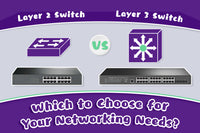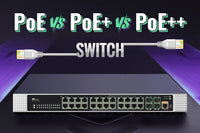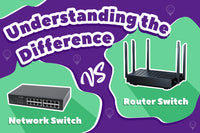Contents
Ethernet switches and hubs are essential network devices connecting multiple devices to the same central station, establishing robust network connections. Both of them play a crucial role in local area networks (LANs) and wide area networks (WANs). Many users may find it difficult to identify network switches and hubs, but in fact there are significant differences between them, especially in the way they work. This article covers the basics, differences and applications of Ethernet switches and hubs, helping you make an informed choice when choosing between them.
What is a Hub?
An Ethernet hub contains multiple network ports to provide a common connection point for various devices in a computer network. Devices within the LAN can communicate with each other using the hub. Hubs work at the first layer of the OSI model, so they are not capable of determining the data transmission path. When the hub receives data signals from the source device, it copies and forwards the data to all other connected devices. The hub may build a shared network with low security.
Ethernet hubs operate in half-duplex mode. It means data can either be sent or received at one time, which slows down the network. The Ethernet hub can serve as an easy and economical solution for small-scale networks.
There are different network hub types, including active and passive hubs. Passive hubs have the basic functions of connecting devices and broadcasting signals. Active hubs require additional power supplies to amplify and regenerate signals. Acting as repeaters to extend the distance between nodes, they allow for scaling of the LAN. Intelligent hubs, the advanced category of active hubs, feature additional network management and switching operations, providing flexible data rates.
What is Ethernet Switch?
An Ethernet switch, also known as a switching hub, and bridging hub, is a type of network hardware that allows for data exchange among multiple connected devices. Switches work intelligently and typically support full-duplex communication, allowing data to be sent and received simultaneously. Moreover, it allocates dedicated full bandwidth to each device.
Ethernet switches work based on MAC addresses. Every network-connected device has its own physical address, which is known as the MAC address. The network switch has a MAC address table to help identify the connected devices and forward data frames. If the destination MAC address is not yet in the table, the switch broadcasts to locate and record the corresponding port and address. When the target device is not within the same LAN, the switch sends the frame to a router to be forwarded to the intended destination. This working process ensures efficient data transmission.
Ethernet switches come in various types, including unmanaged and managed switches, layer 2 and layer 3 switches, PoE switches, modular switches, etc. You can find out more via our related blogs.
What is the Difference Between an Ethernet Hub and Switch?
Now that you have a basic understanding of Ethernet hubs and switches. We’ll further explore their key differences in the following content.
- Operation Layer: A hub operates at the physical layer (layer 1) of the Open Systems Interconnection (OSI) model. The Ethernet hub functions like an extension cable, merely copying and sending data to all connected devices within a network. With this broadcast mechanism, all connected devices should receive data and decide for themselves whether to process or discard it.
Switches usually operate at the data link layer (layer 2) of the OSI model. They can identify the destination device by MAC address and forward data to the corresponding device. Some switches also operate at the network layer (layer 3), known as layer 3 switches. These switches use IP routing tables to forward data and handle traffic across different LANs and VLANs (virtual local area networks). Switches provide superior performance, especially during periods of high traffic.

- Bandwidth: The network hub transmits data to all connected devices, so the bandwidth is shared among these devices, which reduces the bandwidth. In addition, due to the lack of data and traffic control, data conflicts and retransmissions may occur frequently. These can cause insufficient network throughput and congestion. Network switches provide a wide range of management options to control and optimize network performance, meaning that every device can get the full bandwidth. Targeted data transmission also increases the bandwidth utilization efficiency of switches.
- Security: Ethernet hubs send the data to all devices across networks, which means that each device within the network can see the traffic. So, Ethernet hubs are not very secure and private information can be easily halted by attackers. Switches can be more secure as they send data to targeted devices. In addition, switches can control MAC addresses and create VLANs for enhanced security.
- Scalability: Ethernet switches offer higher scalability to support network expansion. They can be connected to more devices without bandwidth reduction and data degradation. In contrast, hubs are less scalable with fewer ports. They can only support the connection with 4 to 12 devices and network congestion can occur with more devices.
- Cost: Hubs usually have a low price and they are relatively obsolete. In fact, they are not often used in modern networks.
Different types of switches vary in price. For example, unmanaged switches are cost-effective, but managed and PoE switches can be more expensive. They are a high-performance alternative to hubs in home networks.
Below is the comparison sheet of Ethernet switches and hubs.
|
|
Ethernet Switch |
Ethernet Hub |
|
Layer |
Layer 2 of the OSI model (data link layer) |
Layer 1 of the OSI model (physical layer) |
|
Data Forward |
Forwards data based on MAC addresses |
Broadcasts to all devices |
|
Device Type |
Intelligent device |
Non-intelligent device |
|
Duplex Mode |
Full or half duplex |
Half duplex |
|
Transmission Type |
Selectively; unicast, multicast or broadcast |
Frame flooding and broadcast |
|
Number of Ports |
Multi-port, usually between 24 and 48 |
Usually between 4 and 12 |
|
Collisions |
Each port has its own collision domain |
One collision domain in total |
|
Security |
Hard to hack, very secure |
Not very secure |
|
Application |
Widely used in modern networks |
Out of date, mainly used in older systems or simple setups |
|
Bandwidth |
Each device has full bandwidth |
Each device shares bandwidth |
Ethernet Switch vs. Hub: How to Choose?
Ethernet switches are commonly used to connect a wide range of devices, including computers, printers, industrial devices, wired access points, and IoT devices. They also integrate with other network infrastructures, such as servers, routers and firewalls. Ethernet switches are the preferred solution for most network environments, including enterprises, campuses, data centers, and small office/ home offices. In addition, they are ideal for creating a high-performance home network.
In contrast, Ethernet hubs are no longer common and are only practical in specific scenarios, such as small-scale or temporary networks, network monitoring, and some industrial networks. They also provide backward compatibility for older systems.
Switches are superior to hubs in many aspects, offering fast speed, privacy and security. In most scenarios, an Ethernet switch is the superior choice.
Final Words
Though Ethernet switches and hubs have very similar appearances, they differ in performance, functionality, and more. The biggest difference lies in how they handle communication between devices within the network. Non-intelligent hubs are being replaced due to their limitations, while switches are a popular choice for modern networks.
For more information on this topic, you can keep up on our blogs. While VCELINK offers general and basic information for our customers and other visitors to the website, it’s not professional advice.



Be the first one to comment.
Leave a comment